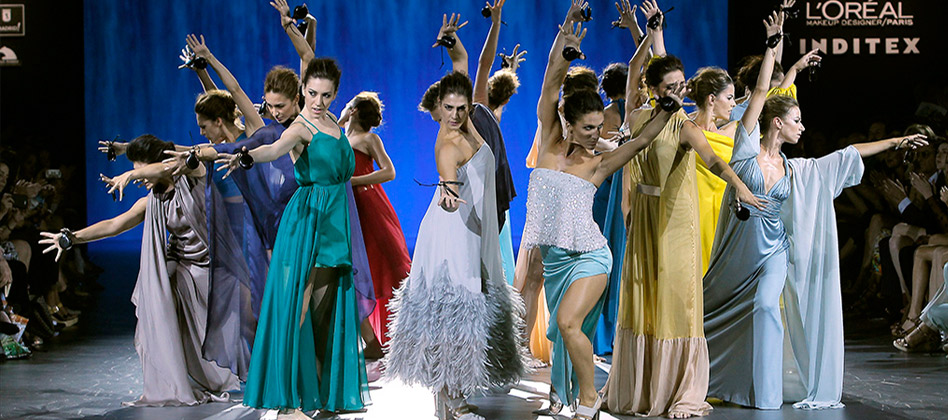Powered by social media, fashion has gone global. From country to country, we’re inspired by international trends which has brought a variety of new colour, cuts and styles to our catwalks.
Putting these global styles on display are the fashion weeks which take place in the world’s fashion capitals, from New York to Paris. But, with such different cultures and designer backgrounds, can we truly compare one nation’s fashion week to another?
With the help or QUIZ, retailer of party dresses, we check out how the trends from London Fashion Week and Mercedes-Benz Fashion Week in Madrid compare.
Differences
There was much crossover between the two fashion weeks, and of course many differences:
Colours
Colour played a huge part in both London and Madrid fashion weeks, from bright orange in Madrid’s Pedro del Hierro AW18 collection to classic khaki in London’s JW Anderson range.
London, however, placed more of an emphasis on colour than Madrid Mercedes-Benz Fashion Week. Take for example Burberry, which presented multi-coloured coats, vivid jumpers and rainbow designs to the catwalk in support of LGBTQ rights. Similarly, Jasper Conran made his show explode with magentas, violets, lemons, and limes — sometimes in the same outfit.
Historic dress codes
The collections by Simone Rocha and Erdem helped inject a historic retrospective into London Fashion Week.
While London Fashion Week was populated by traditional tweed, collars and necklines, Madrid had a much greater focus on contemporary and 80s-inspired styles, showing how infused culture and history are within fashion.
The 1970s
Sequin dresses and platform shoes helped bring a 1970s vibe to London Fashion Week. In London, Michael Halpern’sAW18 collection was spearheaded by disco-inspired clothing — mainly shimmery fabrics, zebra prints and retro jumpsuits. Then, there wasLondon’s Roland Mouret, who brought retro fabrics like velvet and corduroy, and Simone Rocha, who infused her vintage collection with hints of 1970s’ punk culture.
In Madrid, the inspiration was firmly taken from the 1980s, featuring molten metallic materials and oversized shoulders. Although, we must mention that, at Spain’s Mercedes-Benz Fashion Week, Ion Fizdid a flawless job of bringing disco-inspired trends to the forefront with clothes and cuts inspired by the iconic Studio 54 club scene in New York City!
Fabrics
Designers in Madrid showcased their ability to create sophisticated silhouettes with silk, chiffon and tulle. Pedro del Hierro and ManéManéare two stand-out examples.
In London, the focus remained on quintessentially British fabrics. At Simone Rocha’s and Emilia Wickstead’s shows, we glimpsed stunning stylings of plaids and tartans — particularly as part of trouser and skirt suits — while brocade played a crucial part in the collections by Erdem, Preen and Roland Mouret.
Similarities
With so many differences, did the two fashion weeks share any similarities?
The 80s theme
From both fashion weeks, it’s clear to see that retro-inspired 1980s fashion is back. From power suits and accentuated shoulders, to pleated skirts and bold prints; major designers in Madrid and London brought back these retro looks with style.
To create the now well-known 1980s silhouette, designers used oversized tops alongside fitted bottoms. For a finishing touch, colourful make-up, ruffles and tailored blazers were added to complete the look.
Strong silhouettes
The Angel Schlesser collection that was showcased in Madrid, along with London’s Roksanda show, highlighted undefined body outlines. From floaty dresses to puffy skirts, this year is set on redefining the feminine shape in Spain and the UK.
In fact, many shows featured looser clothing shapes, moving away from figure-hugging clothes that create hourglass shapes. For example, rather than emphasising this outline, we see more clothing that accentuates the upper half of the body — most notably in the push towards 1980s fashion. Similarly, there’s been heavy use of tulle in both Spanish and UK collections, which typically puffs out as opposed to clinging to the body. And there’s also been hundreds of silk shirts and dresses that are designed to glide over women’s figures, rather than tightly hug them.
Inspiration from art
Across both Madrid and London shows, the influence of art was present. For example,the art of dance encouraged London Fashion Week’s RoksandaIlincic to create fluid clothing that fitted the body perfectly regardless of movement, while Carolina Menéndez of Madrid’s fashion week used the designs of painter, Mark Rothko, to create an abstract and expressive collection for her AW18 season.
Inspired by Asia
An Asian influence was present across both fashion weeks. The Far East was flawlessly represented in the shows by Marcos Luengo and ManéMané in Spain, which featured plenty of silk garments and floral patterns reminiscent of traditional oriental designs. Similarly, at London Fashion Week, there was a notable presence of innovative Asian designers, including RejinaPyo, Huishan Zhang and Ashish Gupta.
If you’re looking for inspiration for your AW18 wardrobe, look no further than the styles featured across London and Madrid fashion weeks.
Featured Image

